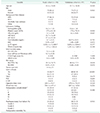Abstract
Purpose
Methods
Results
Figures and Tables
Fig. 1
Receiver operating characteristic curve of clinically relevant posthepatectomy liver failure (International Study Group of Liver Surgery grades B and C). (A) At a cutoff value of <140 (109/L), platelet count had a sensitivity of 86.7%, and specificity of 74.7% for predicting clinically relevant posthepatectomy liver failure. The optimal cutoff value for remnant liver volume-to-body weight (RLV/BW) ratio was 0.55 (sensitivity, 80%; specificity, 73.3%), while remnant liver volume/total functional liver volume (RLV/TFLV) ratio was 35 (sensitivity, 80%; specificity, 57.3%) of the primary cohort. (B) Optimal value of liver stiffness is 11.1 kPa (sensitivity, 66.7%; specificity, 57.3%), while indocyanine green retention rate at 15 minutes has an optimal cutoff value of 11.1 (sensitivity, 26.7%; specificity, 76%) of the primary cohort. (C) In the validation cohort, the optimal cutoff values for platelet count, RLV/BW ratio, and RLV/TFLV ratio were the same as the primary cohort.

Fig. 2
Percentage risk of patients with hepatocellular carcinoma who underwent right hepatectomy according to the number of risk factors (platelet count < 140 [109/L] and remnant liver volume-to-body weight ratio < 0.55). (A) Primary cohort and (B) validation cohort. High risk, platelet count < 140 (109/L), and RLV/BW ratio < 0.55; intermediate risk, either platelet count < 140 (109/L) or RLV/BW ratio < 0.55; low risk, platelet count > 140 (109/L) and RLV/BW ratio > 0.55. CRPHLF, clinically relevant posthepatectomy liver failure; RLV/BW, remnant liver volume-to-body weight.

Fig. 3
Percentage risk of patients with hepatocellular carcinoma who underwent right hepatectomy according to the (platelet count < 140 [109/L] and remnant liver volume-to-body weight ratio < 0.55). (A) Patients with liver cirrhosis and (B) patients with no liver cirrhosis. High risk, platelet count < 140 (109/L) and RLV/BW ratio < 0.55; intermediate risk, either platelet count < 140 (109/L) or RLV/BW ratio < 0.55; low risk, platelet count > 140 (109/L) and RLV/BW ratio > 0.55. CRPHLF, clinically relevant posthepatectomy liver failure; RLV/BW, remnant liver volume-to-body weight.

Table 1
Clinical characteristics of patients in the primary study cohort and validation cohorts who underwent right hepatectomy for hepatocellular carcinoma

Values are presented as mean ± standard deviation or number (%).
INR, international normalized ratio; PIVKA, protein induced by vitamin K absence/antagonist; ICG R15, indocyanine green retention rate at 15 minutes; MELD, model for end-stage liver disease; RLV, remnant liver volume; TFLV, total functional liver volume; BW, body weight; TACE, transarterial chemoembolization; PVE, portal vein embolization; CCRT, concurrent chemoradiotherapy.
a)Postoperative complication was assessed by Clavien-Dindo classification.
Table 2
Comparisons of clinicopathologic variables between the groups with or without CRPHLF after right hepatectomy

Values are presented as mean ± standard deviation or number (%).
CRPHLF, clinically relevant posthepatectomy liver failure; PT-INR, prothrombin time-international normalized ratio; ICG R15, indocyanine green retention rate at 15 minutes; RLV, remnant liver volume; TFLV, total functional liver volume; BW, body weight; TACE, transarterial chemoembolization; CCRT, concurrent chemoradiotherapy.




 PDF
PDF ePub
ePub Citation
Citation Print
Print




 XML Download
XML Download